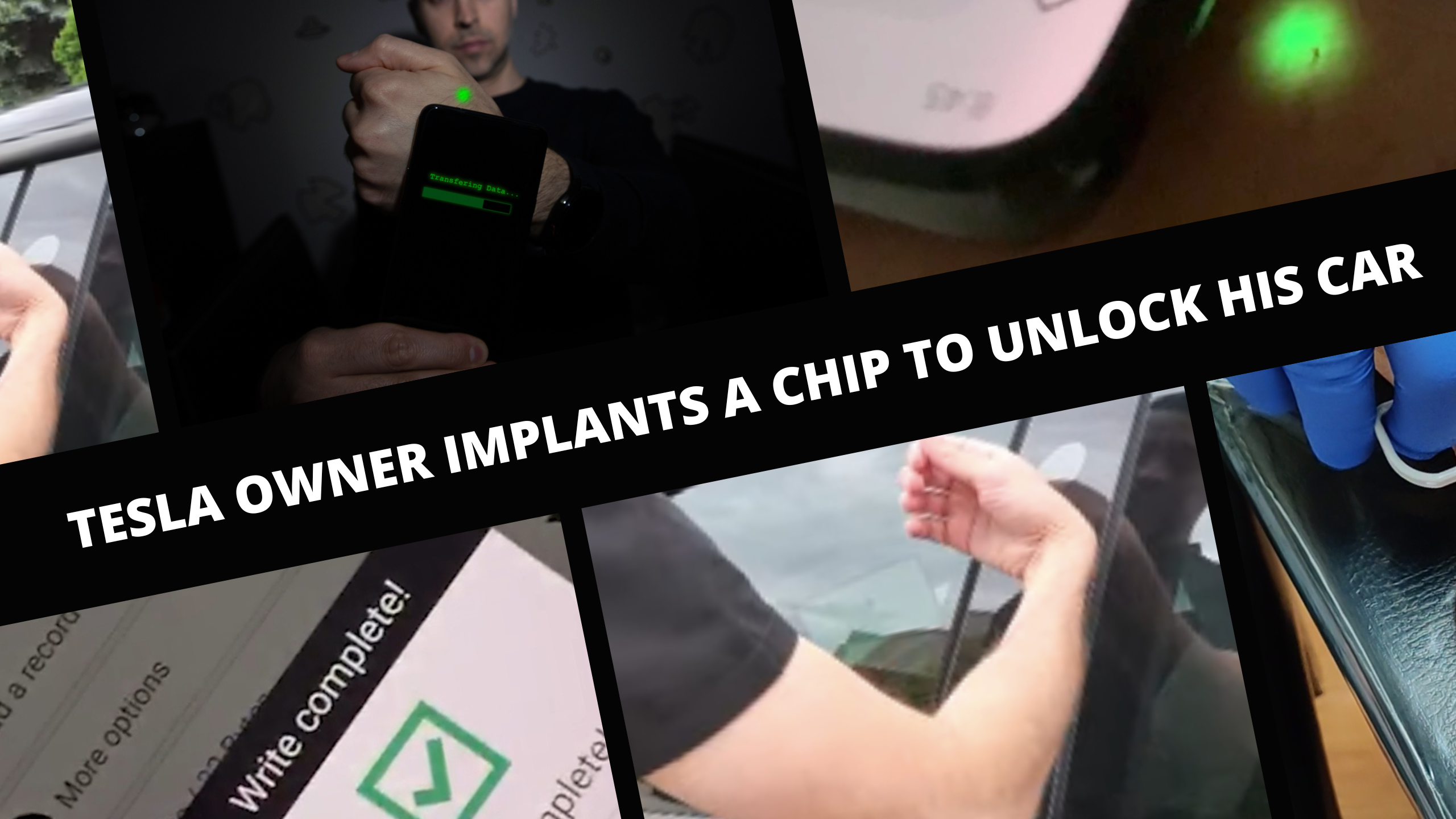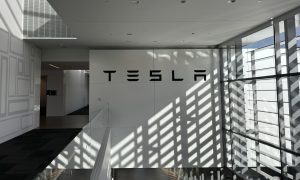Brandon Dalaly, a Tesla owner, has a unique way of unlocking his car: with his hand. Or rather, with the specially made chip that was implanted in his hand eleven days ago. I spoke with him about his new implant and he told me that this was actually his second one.
The first thing I wanted to know was how bad it hurt. If you watch this video, you’ll probably wince in imaginary pain as I did. Brandon explained that this was his second chip. When he received his first one, he did not use any anesthesia or anything to numb it.
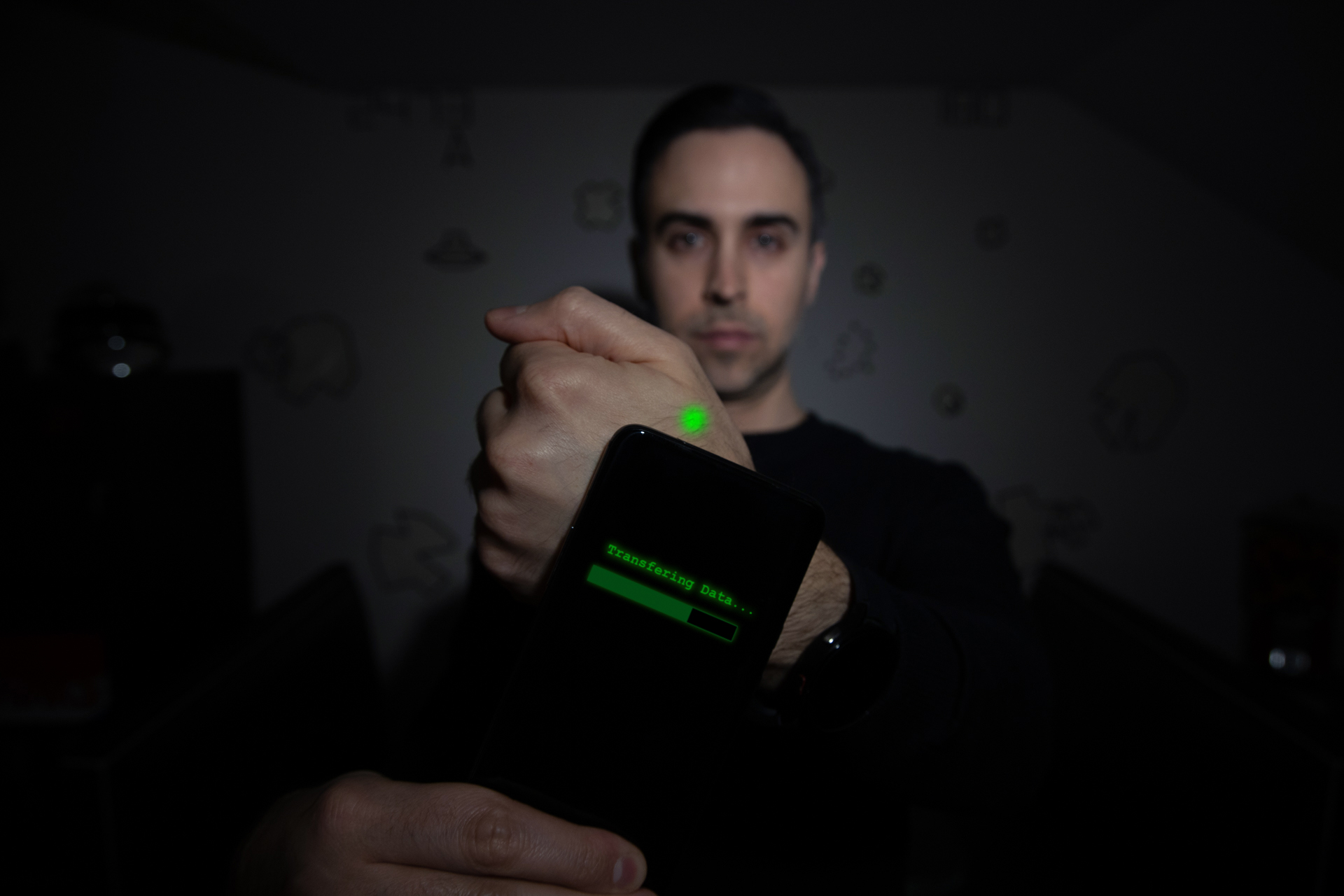
“The first one was a little bit smaller so it wasn’t as intense as shoving that giant rod into my hand. The first one came preloaded into a larger syringe. They pushed the syringe in and they popped in the chip similar to how they would microchip a dog.”
The first chip implant burned and was sore for about a month. However, for the second one which is what is used to unlock his Tesla, his hand was anesthetized with lidocaine. Brandon said a four-gauge needle was used.
The chips, he explained, are coated in biocompatible substances such as biopolymer. His other one is a bioglass. Once implanted, the body encapsulates the chip with its own tissue.
Why Two Chips?
I was curious as to why Brandon had two chip implants. He explained that they do completely different things. The chips are used for a variety of purposes such as access control, storing data, lighting up under your skin, or storing cryptocurrencies. Brandon is actually beta testing the chip he uses to unlock his Tesla.
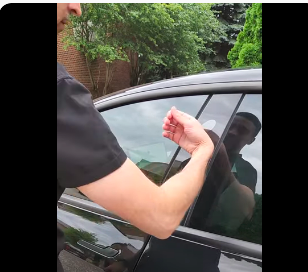
The chip that Brandon uses to unlock his Tesla is the VivoKey Apex which is a contactless NFC secure element chip.
“I’m in a beta group of around 100 people and this one can do secure transactions and java card applets. The company that put this together literally has its own app store where you can wirelessly install apps into your body with these chips. And one of the apps just happened to be a Tesla key card. So that was the first app I installed on it because I have a Tesla and now I use that as my key when my Bluetooth key fails or I don’t have my key card. You just use your hand.”
The first chip, Brandon explained, is the key to his home and stores his portfolio, his contact card, medical information, Covid vaccination card, and similar items. The chip can be scanned with any cell phone which then opens a portal you can access the information.
“The whole idea was that I would have my house key in my left hand and my car key in my right hand. And then what’s really cool is when it’s approved, they can wirelessly activate the new chip I just got to do credit card transactions. I can link a credit card to it and I can use it anywhere where there are tap-to-pay terminals.”
The Obvious Concern: accidently being close to something that would scan the chip and use it.

One concern I had was what if the chip was accidently used or accessed. Or, worst case scenario, hacked? For example, would a nearby credit card machine accidently scan your chip and access your money? Brandon explained that the chip had to be very close for the machine to read it.
“You have to be within a few millimeters of the thing and realistically, hopefully, you’re not just walking through credit card terminals and brushing your hands against them during mid transactions.”
“It’s a very short read range. It’s no different from your phone if you use Apple Pay. It’s like that but it’s built in your hand.”
Will Brandon get more chips?
Could this be the tech version of tattoo addictions? I asked Brandon if he had plans for getting any more chips in the future. Brandon works in tech and `is always trying to be on the cutting edge of everything.
“For me, it’s something that made sense at the time. It’s kind of like a fun party trick. When you can one of my chips with your phone, it glows green underneath your skin.”
There is another chip but it’s not yet available in the U.S. just yet. This one measures your body temperature. The capsule is installed in your chest and you can scan it with your phone and take your temperature.
“We’re at the dawn of this technology and it’s a very niche product. And there’s been a lot of pushback. People thought that Bill Gates was putting tracking chips in the Covid vaccine. It fuels a lot of conspiracy theories.”
“It’s funny because these chips can’t track anything. You would need an external power supply to be tracked anywhere. And their phones are tracking them everywhere they go anyway. If you go to your Google location history, it shows you step-by-step where you’ve been.”
“And there’s the religious people who have sent me a bunch of weird comments on Facebook about the mark of the beast on the video of my first chip installation. There’s something in the Book of Revelation that talks about this mark in your hand or forehead that shows your allegiance to Satan or something like that. I just don’t want to have to worry about forgetting my car keys. I’m not over here worshiping Satan.”
Cost of getting the Tesla key card chip implanted.
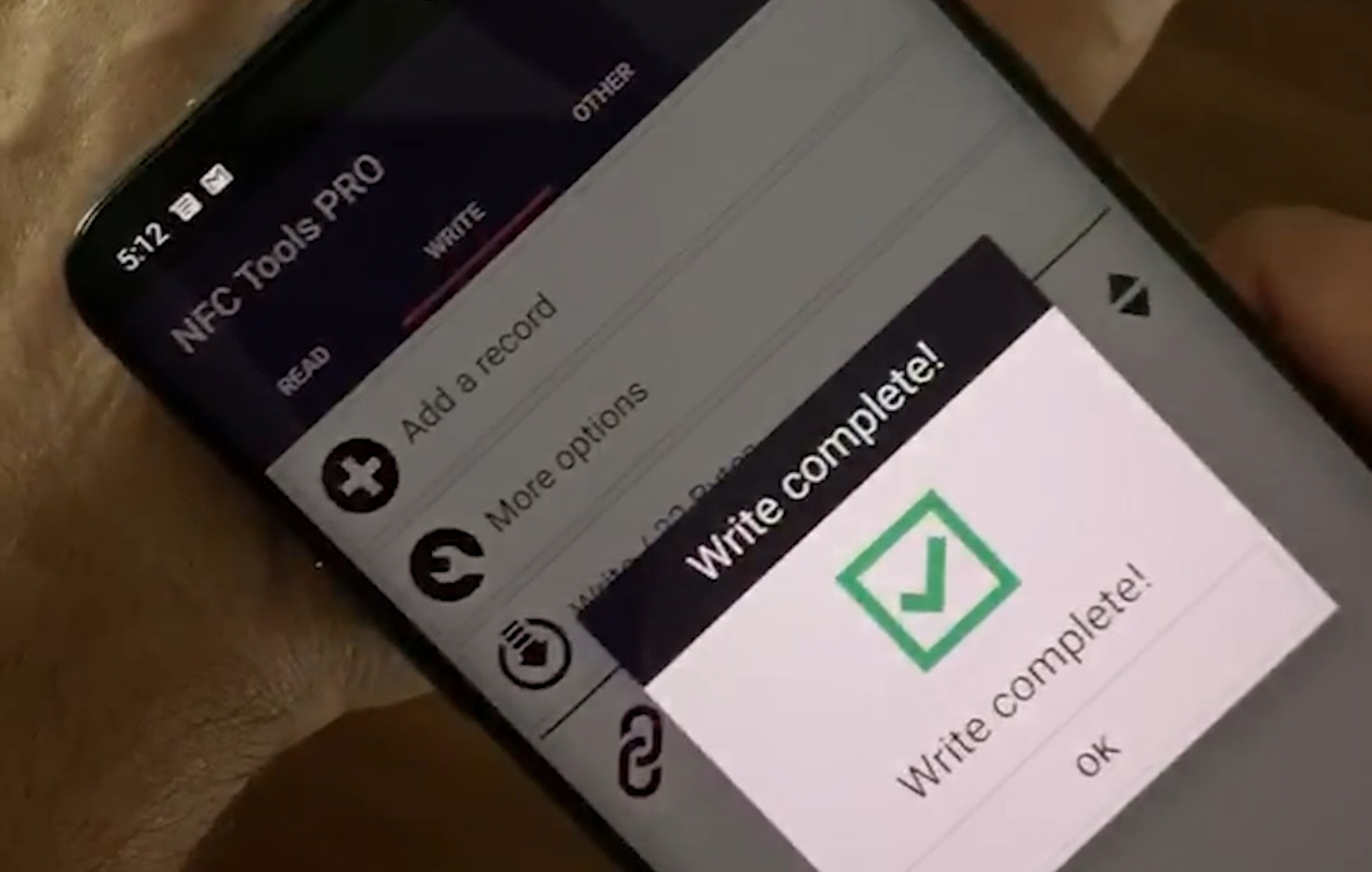
Credit: Brandon Dalaly
If you were to guess how much this would cost, you might be shocked at how wrong you may be. Unless you guessed $400.
“It’s not as bad as people think. Since I was a beta tester, I got the chip for $300 and then my installer charged me just $100 to put it in. To him, it was the same as a subdermal piercing. It’s the same method but he was sticking in something different.”
Brandon’s installer has been a professional piercer for over 15 years. What do you think? Would you consider having a chip installed in your hand to unlock your Tesla or smart car?
Disclaimer: Johnna is long Tesla.
Your feedback is important. If you have any comments, concerns, or see a typo, you can email me at johnna@teslarati.com. You can also reach me on Twitter @JohnnaCrider1
News
Tesla begins Robotaxi certification push in Arizona: report
Tesla seems serious about expanding its Robotaxi service to several states in the coming months.

Tesla has initiated discussions with Arizona transportation regulators to certify its driverless Robotaxi service in the state, as per a recent report from Bloomberg News. The move follows Tesla’s launch of its Robotaxi pilot program in Austin, Texas, as well as CEO Elon Musk’s recent comments about the service’s expansion in the Bay Area.
The Arizona Department of Transportation confirmed to Bloomberg that Tesla has reached out to begin the certification process for autonomous ride-sharing operations in the state. While details remain limited, the outreach suggests that Tesla is serious about expanding its driverless Robotaxi service to several territories in the coming months.
The Arizona development comes as Tesla prepares to expand its service area in Austin this weekend, as per CEO Elon Musk in a post on X. Musk also stated that Tesla is targeting the San Francisco Bay Area as its next major market, with a potential launch “in a month or two,” pending regulatory approvals.
Tesla first launched its autonomous ride-hailing program on June 22 in Austin with a small fleet of Model Y vehicles, accompanied by a Tesla employee in the passenger seat to monitor safety. While still classified as a test, Musk has said the program will expand to about 1,000 vehicles in the coming months. Tesla will later upgrade its Robotaxi fleet with the Cyercab, a two-seater that is designed without a steering wheel.
Sightings of Cybercab castings around the Giga Texas complex suggests that Tesla may be ramping the initial trial production of the self-driving two-seater. Tesla, for its part, has noted in the past that volume production of the Cybercab is expected to start sometime next year.
In California, Tesla has already applied for a transportation charter-party carrier permit from the state’s Public Utilities Commission. The company is reportedly taking a phased approach to operating in California, with the Robotaxi service starting with pre-arranged rides for employees in vehicles with safety drivers.
News
Tesla sets November 6 date for 2025 Annual Shareholder Meeting
The automaker announced the date on Thursday in a Form 8-K.

Tesla has scheduled its 2025 annual shareholder meeting for November 6, addressing investor concerns that the company was nearing a legal deadline to hold the event.
The automaker announced the date on Thursday in a Form 8-K submitted to the United States Securities and Exchange Commission (SEC). The company also listed a new proposal submission deadline of July 31 for items to be included in the proxy statement.
Tesla’s announcement followed calls from a group of 27 shareholders, including the leaders of large public pension funds, which urged Tesla’s board to formally set the meeting date, as noted in a report from The Wall Street Journal.
The group noted that under Texas law, where Tesla is now incorporated, companies must hold annual meetings within 13 months of the last one if requested by shareholders. Tesla’s previous annual shareholder meeting was held on June 13, 2024, which placed the July 13 deadline in focus.
Tesla originally stated in its 2024 annual report that it would file its proxy statement by the end of April. However, an amended filing on April 30 indicated that the Board of Directors had not yet finalized a meeting date, at least at the time.
The April filing also confirmed that Tesla’s board had formed a special committee to evaluate certain matters related to CEO Elon Musk’s compensation plan. Musk’s CEO performance award remains at the center of a lengthy legal dispute in Delaware, Tesla’s former state of incorporation.
Due to the aftermath of Musk’s legal dispute about his compensation plan in Delaware, he has not been paid for his work at Tesla for several years. Musk, for his part, has noted that he is more concerned about his voting stake in Tesla than his actual salary.
At last year’s annual meeting, TSLA shareholders voted to reapprove Elon Musk’s compensation plan and ratified Tesla’s decision to relocate its legal domicile from Delaware to Texas.
Elon Musk
Grok coming to Tesla vehicles next week “at the latest:” Elon Musk
Grok’s rollout to Tesla vehicles is expected to begin next week at the latest.

Elon Musk announced on Thursday that Grok, the large language model developed by his startup xAI, will soon be available in Tesla vehicles. Grok’s rollout to Tesla vehicles is expected to begin next week at the latest, further deepening the ties between the two Elon Musk-led companies.
Tesla–xAI synergy
Musk confirmed the news on X shortly after livestreaming the release of Grok 4, xAI’s latest large language model. “Grok is coming to Tesla vehicles very soon. Next week at the latest,” Musk wrote in a post on social media platform X.
During the livestream, Musk and several members of the xAI team highlighted several upgrades to Grok 4’s voice capabilities and performance metrics, positioning the LLM as competitive with top-tier models from OpenAI and Google.
The in-vehicle integration of Grok marks a new chapter in Tesla’s AI development. While Tesla has long relied on in-house systems for autonomous driving and energy optimization, Grok’s integration would introduce conversational AI directly into its vehicles’ user experience. This integration could potentially improve customer interaction inside Tesla vehicles.
xAI and Tesla’s collaborative footprint
Grok’s upcoming rollout to Tesla vehicles adds to a growing business relationship between Tesla and xAI. Earlier this year, Tesla disclosed that it generated $198.3 million in revenue from commercial, consulting, and support agreements with xAI, as noted in a report from Bloomberg News. A large portion of that amount, however, came from the sale of Megapack energy storage systems to the artificial intelligence startup.
In July 2023, Musk polled X users about whether Tesla should invest $5 billion in xAI. While no formal investment has been made so far, 68% of poll participants voted yes, and Musk has since stated that the idea would be discussed with Tesla’s board.
-

 Elon Musk2 weeks ago
Elon Musk2 weeks agoTesla investors will be shocked by Jim Cramer’s latest assessment
-

 Elon Musk1 day ago
Elon Musk1 day agoxAI launches Grok 4 with new $300/month SuperGrok Heavy subscription
-

 Elon Musk3 days ago
Elon Musk3 days agoElon Musk confirms Grok 4 launch on July 9 with livestream event
-

 News1 week ago
News1 week agoTesla Model 3 ranks as the safest new car in Europe for 2025, per Euro NCAP tests
-

 Elon Musk2 weeks ago
Elon Musk2 weeks agoA Tesla just delivered itself to a customer autonomously, Elon Musk confirms
-

 Elon Musk1 week ago
Elon Musk1 week agoxAI’s Memphis data center receives air permit despite community criticism
-

 Elon Musk2 weeks ago
Elon Musk2 weeks agoTesla’s Omead Afshar, known as Elon Musk’s right-hand man, leaves company: reports
-

 News2 weeks ago
News2 weeks agoXiaomi CEO congratulates Tesla on first FSD delivery: “We have to continue learning!”

